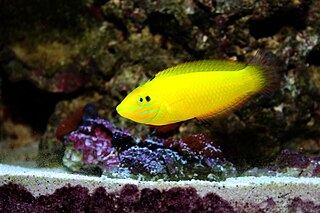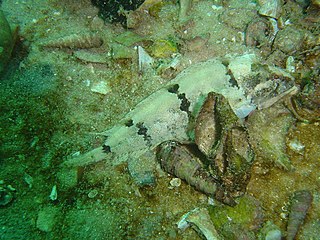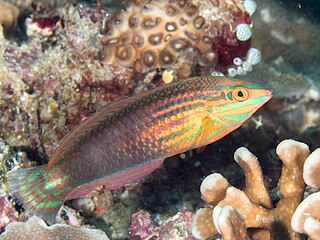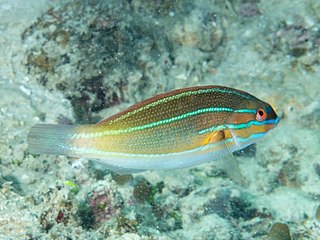
The checkerboard wrasse is a fish belonging to the wrasse family. It is native to the area including the Indian Ocean to central Pacific Ocean.
Pseudanthias heemstrai, the orange-headed anthias, Heemstra's anthias or redhead anthias is a species of marine ray-finned fish in the genus Pseudanthias, the subfamily Anthiinae of the family Serranidae, the groupers and sea basses. It is endemism to the Red Sea. It occasionally makes its way into the aquarium trade. It grows to a size of 13 cm in length.

Pseudanthias rubrizonatus, the red-belted anthias, liliac-tip basslet, deepsea fairy basslet, lilac-tipped seaperch, redband anthias, red-band basslet or redbar anthias is a species of marine ray-finned fish, an anthias from the subfamily Anthiinae part of the family Serranidae, the groupers and sea basses. It is found in the Indo-Pacific. It occasionally makes its way into the aquarium trade. It grows to a size of 12 cm in length.

Cephalopholis fulva, the coney or the butterfish, is a species of marine ray-finned fish, a grouper from the subfamily Epinephelinae which is in the family Serranidae which also includes the anthias and sea basses. It is found in the western Atlantic. It is associated with reefs and is a quarry species for commercial and recreational fisheries. It can be found in the aquarium trade.

Halichoeres chrysus, commonly called the canary wrasse, golden wrasse or yellow wrasse, is a fish species in the wrasse family native to central Indo-Pacific area.

Clinus agilis, the agile klipfish, is a species of clinid found in subtropical waters of the Atlantic Ocean from Namibia to South Africa where it is commonly found in estuaries and tide pools. This species can reach a maximum length of 10 centimetres (3.9 in).

The red-lined wrasse, two-spotted wrasse or biocellated wrasse, Halichoeres biocellatus, is a species of wrasse native to shallow tropical waters in the western Pacific Ocean.

Epinephelus spilotoceps, the foursaddle grouper or spotty cod, is a species of marine ray-finned fish, a grouper from the subfamily Epinephelinae which is part of the family Serranidae, which also includes the anthias and sea basses. It is found in the Indo-Pacific region.

The blue blanquillo, Malacanthus latovittatus, also known as the banded blanquillo, striped blanquillo, false whiting, sand tilefish or eye of the sea, is a species of marine ray-finned fish, a tilefish belonging to the family Malacanthidae. It is found in the Indo-Pacific.

Coris cuvieri, the African wrasse, African coris or false clowwrasse, is a species of marine ray-finned fish from the wrasse family Labridae which is found in the Indian Ocean and the Red Sea. It is sometimes found in the aquarium trade.

Stethojulis trilineata, also known as the blue-ribbon wrasse, red shouldered rainbow-fish, scarlet-banded rainbowfish, three-blueline wrasse, three-lined rainbowfish or three-lined wrasse, is a species of marine ray-finned fish, a wrasse from the family Labridae. It is found in the Indo-Pacific region where it is associated with reefs.
Cirrhilabrus shutmani, also known as the magma fairy wrasse, was discovered by RVS Fishworld in 2016 living around the Didicas Volcano in the Babuyan Islands of the Philippines. The magma wrasse belongs to the family of 'Labridae', a colourful species of tropical and subtropical fish. The magma wrasse is found in tropical coral reef, within the depth range of 50–70 metres (160–230 ft). This species of fish usually inhabits steep slopes around coral reefs made up of loose rubble. It can be purchased within the aquarium trade.

Cirrhilabrus pylei, commonly called the blue-margin fairy-wrasse or Pyle's wrasse, is a species of fairy wrasse. It can be found in depths of 55 to 82 m (180–269 ft) in Indonesia, Papua New Guinea, Solomon Islands and Vanuatu; reports from the Philippines is due to confusion with C. briangreenei. C. pylei can be kept in aquariums and is known for its peaceful temperament. The fish has also been known to jump from tanks.
Hologymnosus longipes, the sidespot longface wrasse or the plain slender wrasse, is a species of marine ray-finned fish from the family Labridae, the wrasses. It occurs in the western Pacific Ocean.

The bleeding wrasse is a species of marine ray-finned fish from the family Labridae, the wrasses. It is found in reefs in the eastern central Pacific Ocean.
Pteragogus trispilus is a species of marine ray-finned fish from the wrasse family, the Labridae. It is native to the Red Sea from where it has entered the Mediterranean Sea.

Cirrhilabrus adornatus is a species of the labrid fish genus Cirrhilabrus and is also known as the red-fin fairy wrasse or Debelius fairy wrasse. They are found in the Eastern Indian Ocean which is known only from Indonesia over a rubble bottom of 1212m. Male Cirrhilabrus adornatus have two large triangular bright red blotches on the body which are white to pale pink. Female with a black spot three-fourths orbit diameter posteriorly on side of caudal peduncle and shading to white ventrally on head and abdomen. They are small species with a height of 63.4 mm SL, body depth 2.9-3.2 in SL, and head length 2.75-3.05 in SL. Cirrhilabrus adornatus is the combination of 45–47 dorsal-fin rays, 28–30 anal fin rays, 50–52 total vertebrae, 51–54 lateral line scales, 8–12 cheek scales, two large scales on each side of the lower jaw undersurface.

Cirrhilabrus cenderawasih is a species of fairy wrasse that is commonl on sheltered seaward reefs, in a world abundant with coral reefs and geographical landscapes. The eastern portions of the Cenderawasih Bay it is more abundant below about 35 m, although at a depth between about 22 to 60 m. They are generally found in Western Pacific, Indonesia. These island groups are highly endemic reef fishes in multiple genera, it is observed around 10 to 20 individuals including one or five males were typically encountered on rubble substrates at the base of slopes. Male Cirrhilabrus cenderawasih is pinkish fading to white near the belly and is typical of the complex. They are yellow elongated blotch runs across the pink/white demarcation that starts from the pectoral fin up to about two-thirds of the body length. The female is complete pink with a single black caudal spot, otherwise, it would be difficult to identify without contextual clues. The length of male Cirrhilabrus cenderawasih is 6.5 cm SL and female 4.7 cm SL. Bird's Head Peninsular lies in the northwest province of West Papua so it is named as head of a bird, and it is the epicenter of three important reefs.

Cirrhilabrus finifenmaa, also known by its common name rose-veiled fairy wrasse, is a rainbow-colored wrasse that is native to the reefs of the Maldives.

Stegastes xanthurus, also known as the Caribbean cocoa damselfish, is a species of damselfish in the family Pomacentridae, found on coral and rocky reefs in the Caribbean Sea and neighboring areas of the Atlantic Ocean and Gulf of Mexico.

















